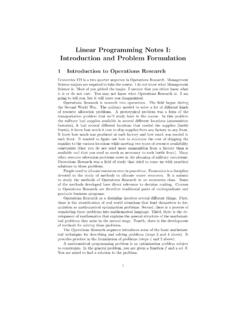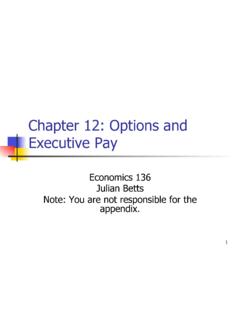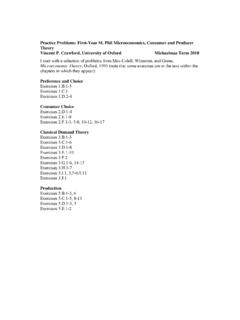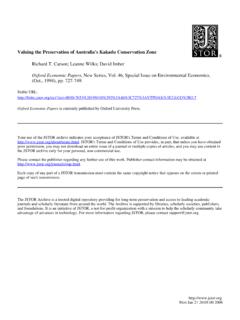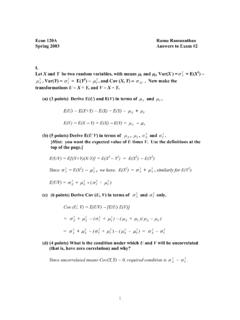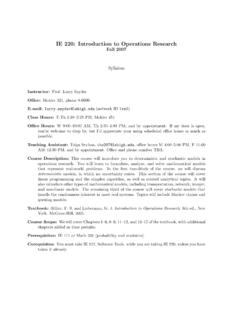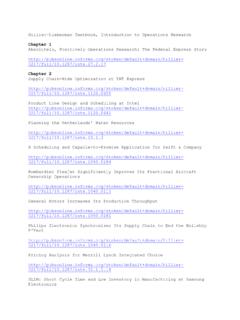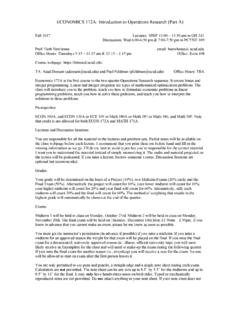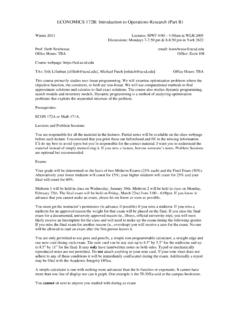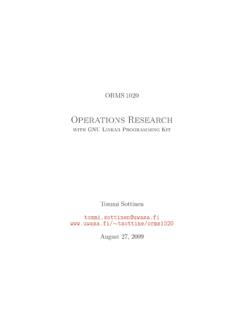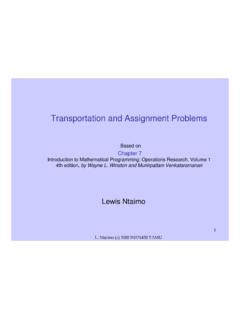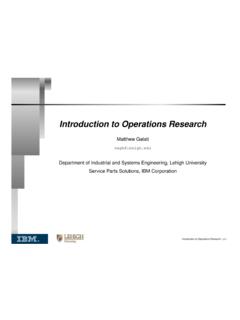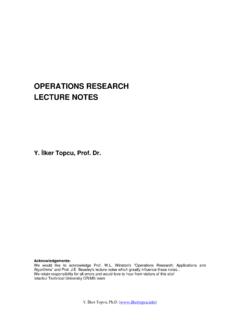Transcription of Introduction to Operations Research Economics …
1 Introduction to Operations ResearchEconomics 172A, fall 2012 General InformationHomepage (with link to handouts for course): jsobel/172f12 and Teaching Assistants:NameOfficeOffice HoursJoel SobelEcon 311 TuTh 2:30 3:20 Leland FarmerEcon 128M 2:30 3:30 Erin GiffinEcon 117Tu 5:00 6:00My office phone: (858) 534-4367 Warning: I will not answer my phone if a student is in the you want to contact us via email, please use the class account: 172A is the first course in the two-quarter Operations Research sequence. It covers linear andinteger programming. Linear and integer programs are types of mathematical optimization problem. Theclass will introduce you to the problems, teach you how to formulate economic problems as programmingproblems, teach you how to solve these problems, and teach you how to interpret the solutions to MaterialI will follow the lecture notes that you can view and download from the class web page or at soft notes concisely describe the main ideas of the notes do not cover everything, nor do theygive all of the details, but they will make lectures easier to follow.
2 Tests cover only material discussed inlectures, lecture notes, and in Bookstore also has copies of (HL) Hillier and Lieberman: Introduction to Operations Research ,McGraw-Hill. Copies of the book are also available at Geisel Reserves. Page references below are to theninth edition. Earlier editions are fine, but pagination may differ. This book is a useful supplement. Youshould buy the book if you have trouble following the lectures or my notes. You should buy the book if youhave more money than you can spend. The book is quite expensive, however, and not essential. Most ofthe material in the course is standard. You can find decent treatments in other sources. See me if you would be useful to have access to software that solvers linear programming problems. There are severaloptions. The Hillier and Lieberman comes with software.
3 Google documents has a free cloud based are also free solvers than are compatible with Microsoft Excel. (Some versions of Excel already havethe solver. In some cases you must download a free add on.) The notes describe how to use Excel s should be comfortable with linear algebra, basic microeconomics, and the operation of a spreadsheetcomputer program. In order to enroll in the class you must have the requirements listed in the UCSD ListI have no authority to add people to the class. Direct all questions to the departmental undergraduateoffice, Sequoyah Hall web page contains links to some material that will not be covered in the class or on will be an in-class midterm examination on Thursday, November 1. There will also be an in-classfinal examination on Monday, December 10 from 3:00 PM-6:000 PM. There will be four short quizzes, to beheld on October 11, October 25, November 15, and November 29.
4 I will determine your grade on the basisof your three best quiz performances (15% total); the midterms (35%); and the final examination (50%).The final will be assignments are an important way to prepare for the examinations. For a variety of reasons, Ifind that they are not a good way to evaluate effort or understanding. I urge you to work problems (availableon the class web page).I do not follow a rule that determines the fraction of the class that receives a particular letter is no strict percentage needed to attain a particular letter grade. I will give vague feedback afterassessments, but I will not provide letter grade information until the end of the to StudyThis course introduces a few ideas and mathematical techniques. You will need to learn the ideas andhow to apply the techniques. Doing so requires practice.
5 The web page has many old problems and examquestions (with solutions). The text also contains many good practice problems. Working these problems isthe best way to prepare for the examinations. Old programs and homework assignments help you develop theskills needed to do well on exams. On examinations I usually want you to demonstrate that you understandhow to solve problems and what the answers will be sections on Tuesdays in York Hall 2262 from 8-9 PM and from 9-10 MattersI will give no late examinations without compelling (and fully documented) medical excuses. I amgenerally unsympathetic to requests for special timing of examinations. Under no circumstances will Ichange the time of a quiz. If you are unable to come to class for one quiz, the other three quizzes willdetermine your may use no electronic devices, notes, books, or your classmates exam papers during the midterm orthe take violations of academic honesty seriously.
6 Any act of academic dishonesty will be reported to youracademic dean, will lead to a failing grade in the course, and possibly dismissal from the university. If youhave any doubts about what constitutes academic dishonesty, please consult and ReferencesBelow is a schedule of topics to be covered and associated readings in (HL). (The page references arefrom the edition that I ordered - earlier editions do not differ greatly. If you have access to an earlier edition,you should have little trouble finding the relevant reading.) In the column labeled problems the first linegives page and problem numbers in Hillier and Liebermann s class web page has links to old problem sets and the last final examination of the course (and answersto these questions). These also contain relevant Problems9-27, 10-2 Introduction /Problem FormulationI30-6077 10; 81 1710-4 GraphingII27 2979 14: 80: 810-9, 10-11 DualityVI:1-6195-206261 1010-11 Quiz I10-16, 10-18 Complementary SlacknessVI: 7-12206 215262: ,610-23, 10-25 Interpretation of DualVI: 12 1710-25 Quiz II10-30 Sensitivity AnalysisVII217 259271 811-1 Midterm Examination11-6 Sensitivity Analysis Continued11-8, 11-13 Integer Programming: BasicsX: 1-4464 491p.
7 524 711-15 Branch and BoundX: 4-8491 515529 6; 530: 311-15 Quiz III11-20, 11-27 Network AlgorithmsX: 8-21358 389412 5, 414 ; 3 511-22No Class Thanksgiving11-29, 12-4 Transportation ProblemVIII304 318, 334 347350 3, 355 611-29 Quiz IV12-4, 12-612-10 Final Examination 3:00 - 6:003
